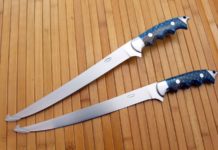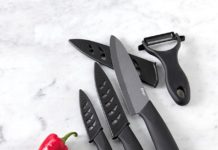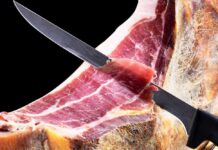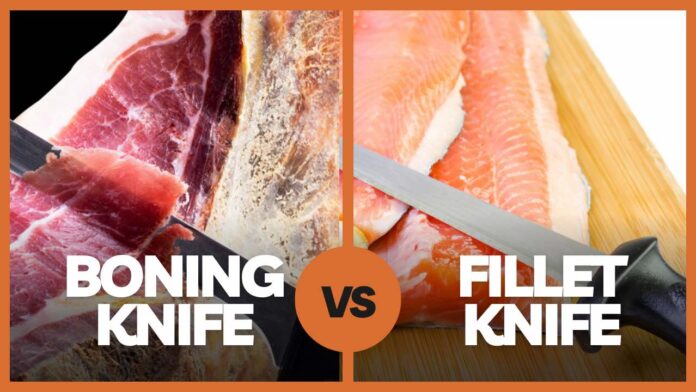
When it comes to selecting the perfect knife for your kitchen needs, understanding the differences between boning knives and fillet knives is essential. Both types of knives have specific purposes and unique designs that can enhance your culinary experience. In this article, we will explore the key differences between boning and fillet knives and provide insight into their respective uses.
A boning knife is designed to separate meat from bones and tends to have a stiffer blade. This makes it an ideal choice for cutting through muscle, tendons, fat, and connective tissue in meats and poultry. On the other hand, a fillet knife features a thinner, more flexible blade, specifically crafted for removing skin from meat and deboning fish. With its prominent curve and fine, sharp point, a fillet knife provides precision and ease when working with seafood.
Knowing the distinction between these two types of knives not only enhances your skills in the kitchen but also allows you to choose the correct tool for each specific task. Whether it’s deboning a chicken with a boning knife or expertly filleting a fish with a fillet knife, having the right tool at hand can make all the difference in the quality of your preparation.
Boning Knife Vs Fillet Knife
Differences in Structure and Design
Boning knives and fillet knives are both essential kitchen tools, but they have distinct differences in their structure and design:
Boning Knife: Typically has a heavier and more rigid blade, which is made from a harder material. This allows it to effectively cut through thicker meat, muscle, tendons, and connective tissue.
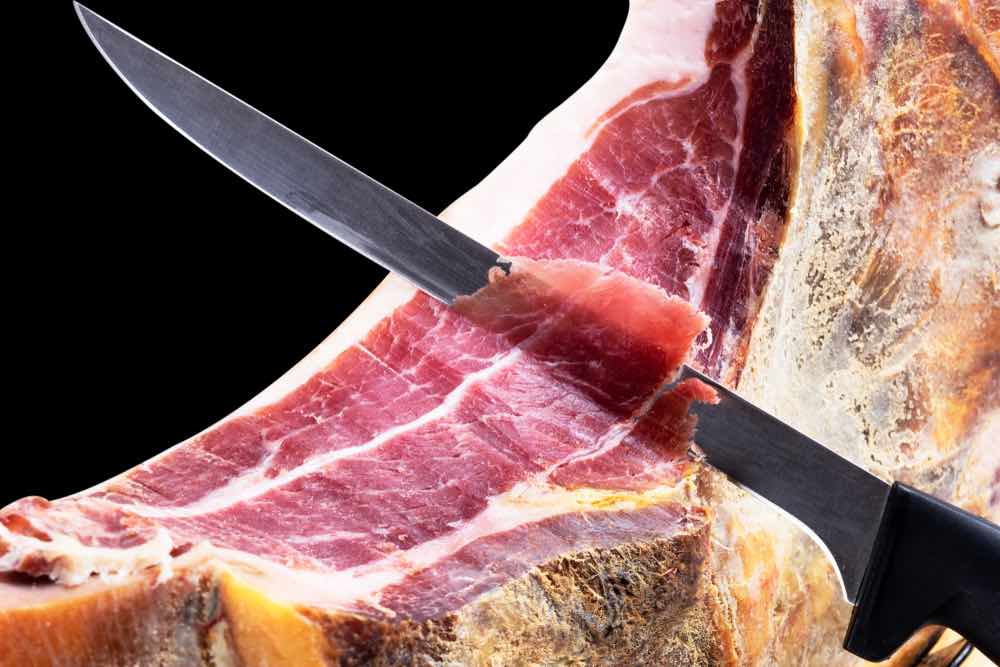
Fillet Knife: Features a lighter and more flexible blade, allowing it to bend and maneuver around small bones and tight spaces. The flexibility makes fillet knives ideal for filleting fish and precisely separating skin from meat.

Functionality and Usage
The primary functionality and typical usage of boning and fillet knives are different:
- Boning Knife: As the name implies, the boning knife is specifically designed for separating meat from bones. Its rigid structure enables it to cut through thick meat and easily slice through the connective tissue between bones and meat.
- Fillet Knife: The main purpose of a fillet knife is to remove the skin from meat, particularly fish. The flexible blade allows for smoother, more precise cuts that follow the contour of the fish, ensuring minimal waste of the meat.
However, it is worth noting that these knives can sometimes be used interchangeably for certain tasks, such as during outdoor camping situations or when one type of knife is not available. For instance, a boning knife can be used to remove skin from fish, though it may not be as efficient and precise as using a fillet knife. Similarly, a fillet knife can be used to separate meat from bones but may lack the rigidity and strength of a boning knife for tougher cuts.
Blade Characteristics
Materials and Flexibility
Boning knives and fillet knives are made of different materials, with the most popular being carbon steel and stainless steel. Carbon steel tends to be stronger and holds a sharp edge longer, while stainless steel resists rust and corrosion. Filleting knives have a more flexible blade, allowing for ease in maneuvering around fish bones and skin. In contrast, boning knives are stiffer, making them more suitable for separating meat from bones and trimming away fat and cartilage in tougher meats and poultry.
Length and Sharpness
The length and sharpness of the blades also differ considerably between boning and fillet knives. Fillet knife blades typically range from 4 to 9 inches in length, with shorter blades being used for smaller fish and longer ones for larger fish. On the other hand, boning knives usually have blades between 5 and 6 inches long, providing sufficient control and precision for cutting through less delicate meats and poultry.
| Knife Type | Blade Length |
|---|---|
| Fillet | 4-9 inches |
| Boning | 5-6 inches |
Both knives should have a sharp edge for efficient cutting. A fillet knife features a thinner, more flexible blade, which makes it easier to separate fish flesh from bones and skin in a neat manner, even for a beginner. Meanwhile, a boning knife has a straight, rigid blade with stronger and stiffer edges, allowing it to cut through the flesh of heavier land animals with more accuracy and ease.
When choosing between a boning knife and a fillet knife, it’s essential to consider the types of tasks and meats you’ll be working with. Keeping these blade characteristics in mind will help ensure you select the most suitable knife for your needs.
Handle and Grip
The handle and grip of a boning knife and a fillet knife play a significant role in their overall functionality and comfort during use. Both knives have unique handle designs catering to their specific purposes.
Boning knives typically have a shorter handle, often measuring around 5 1/4 inches long. They are designed to provide a firm grip and control for separating meat and bone from land animals. Some boning knives feature ergonomic handle designs to reduce hand fatigue during extended use. Materials used for boning knife handles include wood, plastic, and rubber, with the emphasis on durability and resistance to slipping when wet.
Fillet knives, on the other hand, generally feature longer handles, which contribute to improved grip and leverage when slicing through fish. The longer handle allows for better control and precision when removing the fish’s skin and navigating around its delicate bones. Fillet knife handles often have non-slip materials and textures to ensure secure handling, particularly when dealing with slippery fish.
To summarize:
- Boning Knife Handles:
- Shorter handle (around 5 1/4 inches long)
- Firm grip and control for separating meat from bone
- Ergonomic designs
- Durable materials, resistant to slipping when wet
- Fillet Knife Handles:
- Longer handle for improved grip and leverage
- Better control and precision when filleting fish
- Non-slip materials and textures to ensure secure handling
Uses in the Kitchen
Boning Knife for Meat
Boning knives are specialized tools in the kitchen, designed for separating meat from bones. They are useful for slicing through muscle, tendons, fat, and connective tissue. They tend to be thicker and stiffer than fillet knives, providing more support when working with larger cuts of meat, such as beef, pork, and poultry. Their rigid structure allows for precise cuts, making them a popular choice among chefs.
Here are some of the typical uses for boning knives in the kitchen:
- Deboning cuts of beef, such as steaks and roasts
- Separating meat from poultry bones, including chicken and turkey
- Trimming excess fat and cartilage from pork cuts, like chops and ribs
Fillet Knife for Fish
Fillet knives, on the other hand, are a chef’s go-to tool when working with fish. They feature a thinner and more flexible blade, with a prominent upward curve along the edge and a sharp curved tip. This design allows for better maneuverability when filleting fish, like trout, ensuring that the skin is separated from the meat with minimal waste. Fillet knives excel at navigating the delicate bones and cartilage found in fish, making them ideal for processing seafood.
Common uses for fillet knives include:
- Removing skin from fish, with clean and precise cuts
- Separating fish fillets from bones and cartilage, preventing waste
- Slicing fish into even, thin portions for easier cooking and better presentation
In the kitchen, both boning and fillet knives serve distinct purposes for processing different types of meat. Having both knives in your collection ensures that you have the right tool for the task, whether you’re working with fish, beef, poultry, or pork. While they may look similar and have some overlapping functions, their unique features and designs make them indispensable for chefs working with various cuts of meat.
Top Picks and Reviews
Best Boning Knives
When it comes to boning knives, we have selected top options available in the market. Here are some of the best choices:
- Wüsthof Classic 6-Inch Flexible Boning Knife: As the best overall option, this knife boasts German-made quality and precision. Its flexibility ensures efficient removal of meat from bones. Check the price on.
- Zwilling J.A. Henckels Four Star Boning Knife, 7 Inch: Known for its German steel construction, this boning knife provides durability and sharpness. It’s ideal for various applications. Check the price on.
Regarding cost, well-made boning knives range between $28 and $158, depending on materials and blade quality.
Best Fillet Knives
Here are some of the top fillet knives available, catered to different needs:
- Bubba Pro Series Lithium Ion Fillet Knife: As the best cordless kit, this knife offers portability and convenience for filleting tasks. Check the price on.
- Old Timer 110 Volt Electric Fillet Knife with 8-foot Cord: For a corded electric option, this knife provides power and efficiency. Check the price on.
- Gerber Controller 8-inch Fillet Knife: Designed for saltwater applications, this fixed blade knife ensures precision and durability in harsh environments. Check the price on.
- Kershaw 7.5-inch Narrow Fillet: As the best option for freshwater use, this knife offers a perfect balance of flexibility and control. Check the price on.
- Kershaw Folding Fillet K-Texture Knife: For a folding fillet knife, this choice combines convenience and functionality into a compact design. Check the price on.
In summary, boning knives are heavier and more rigid, suitable for separating meat from bones in larger land animals, while fillet knives are lighter, flexible, and ideal for filleting fish. Both types have their top picks and can meet different requirements based on your needs.
Conclusion and Recommendations
When it comes to choosing between a boning knife and a fillet knife, consider the type of meat and task at hand. Boning knives are designed for separating meat from the bone and cutting through sinew, muscle, fat, and connective tissue. They are typically harder and work well on tougher meats and poultry.
On the other hand, fillet knives feature thinner, more flexible blades, designed to glide between the skin and flesh of fish. They are most suitable for fish and delicate seafood.
In order to make an informed decision on which knife to invest in, here are some recommendations:
- Usage: If an individual cooks mainly fish and seafood dishes, a fillet knife is the better choice. But, if the individual works with a variety of meats and needs a versatile tool, a boning knife might be more appropriate.
- Blade length and materials: Fillet knives usually come in lengths ranging from 10 to 23 cm, while boning knives have varying lengths as well. The choice depends on the size and type of meat or fish being prepared. In terms of materials, consider the quality and ability of the blade to hold its sharpness.
- Price range: Well-made fillet knives can cost anywhere from $28 to $158. The price may depend on the materials, durability, and blade performance. Shop within your budget while considering the quality of the knife in relation to its price.
In summary, both boning and fillet knives have their benefits and applications. By taking into account the recommendations above, one can make an informed choice based on their culinary needs and preferences.
Check Out These Other Knife Posts:
The Best Boning Knives
The Best Fish Filleting Knives
The Best Knife Sharpeners For Kitchen Knives


